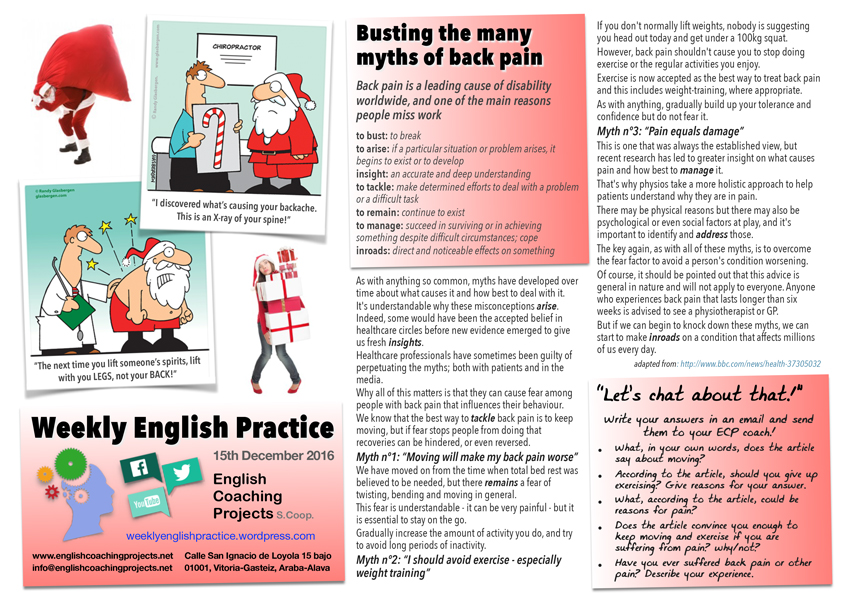Click on the image to download the pdf
Back pain is a leading cause of disability worldwide, and one of the main reasons people miss work
Vocabulary. Read and check you understand this before you read and listen to the article:
to bust: to break
to arise: if a particular situation or problem arises, it begins to exist or to develop
insight: an accurate and deep understanding
to tackle: make determined efforts to deal with a problem or a difficult task
to remain: continue to exist
to manage: succeed in surviving or in achieving something despite difficult circumstances; cope
inroads: direct and noticeable effects on something
As with anything so common, myths have developed over time about what causes it and how best to deal with it.
It’s understandable why these misconceptions arise. Indeed, some would have been the accepted belief in healthcare circles before new evidence emerged to give us fresh insights.
Healthcare professionals have sometimes been guilty of perpetuating the myths; both with patients and in the media.
Why all of this matters is that they can cause fear among people with back pain that influences their behaviour.
We know that the best way to tackle back pain is to keep moving, but if fear stops people from doing that recoveries can be hindered, or even reversed.
Myth nº1: “Moving will make my back pain worse”
We have moved on from the time when total bed rest was believed to be needed, but there remains a fear of twisting, bending and moving in general.
This fear is understandable – it can be very painful – but it is essential to stay on the go.
Gradually increase the amount of activity you do, and try to avoid long periods of inactivity.
Myth nº2: “I should avoid exercise – especially weight training”
If you don’t normally lift weights, nobody is suggesting you head out today and get under a 100kg squat.
However, back pain shouldn’t cause you to stop doing exercise or the regular activities you enjoy.
Exercise is now accepted as the best way to treat back pain and this includes weight-training, where appropriate.
As with anything, gradually build up your tolerance and confidence but do not fear it.
Myth nº3: “Pain equals damage”
This is one that was always the established view, but recent research has led to greater insight on what causes pain and how best to manage it.
That’s why physios take a more holistic approach to help patients understand why they are in pain.
There may be physical reasons but there may also be psychological or even social factors at play, and it’s important to identify and address those.
The key again, as with all of these myths, is to overcome the fear factor to avoid a person’s condition worsening.
Of course, it should be pointed out that this advice is general in nature and will not apply to everyone. Anyone who experiences back pain that lasts longer than six weeks is advised to see a physiotherapist or GP.
But if we can begin to knock down these myths, we can start to make inroads on a condition that affects millions of us every day.
“Let’s chat about that!”
Write your answers and send them by email to your ECP coach. Why not record your voice too? Listen to yourself speak and identify what you have to improve on 🙂
- What, in your own words, does the article say about moving?
- According to the article, should you give up exercising? Give reasons for your answer.
- What, according to the article, could be reasons for pain?
- Does the article convince you enough to keep moving and exercise if you are suffering from pain? why/not?
- Have you ever suffered back pain or other pain? Describe your experience.
adapted from: http://www.bbc.com/news/health-37305032


